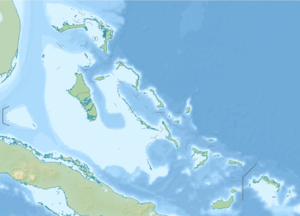San Salvador (Bahamas)
| San Salvador | ||
|---|---|---|
| NASA image | ||
| Waters | Atlantic Ocean | |
| Archipelago | Bahamas | |
| Geographical location | 24 ° 2 ′ N , 74 ° 29 ′ W | |
|
|
||
| length | 19.25 km | |
| width | 8 kilometers | |
| surface | 94.9 km² | |
| Residents | 930 (2010) 9.8 inhabitants / km² |
|
| main place | Cockburn Town | |
| map | ||
San Salvador is an island and a district on the northeastern edge of the Bahamas . With an area of 94.9 km², the island is 11.2 km long from east to west and 19.25 km from north to south. With the exception of the area around Cockburn Town in the west, it is surrounded by several coral reefs , so that ships can only enter here.
History and naming
Around 1680 the English pirate John Watling (or George Watling) named the island after himself, and the name Watling Island lasted until 1925. In that year, the House of Assembly , the parliament of the Bahamas, decided to return the island to San Salvador (span. for "Holy Redeemer") and thus to give it back the name that Christopher Columbus had chosen for the island. The research of the Benedictine Father Chrysostom Schreiner OSB , who had put together evidence that San Salvador / Watling Island was the island of Guanahani , where Columbus first entered the New World , was decisive for the renaming . Until the beginning of the 19th century, the island known today as Cat Island was called San Salvador .
The renaming in San Salvador helped to revive the economy of the island , which had been lying on the ground since the abolition of slavery in 1834, through tourism.
In 2010, around 900 people lived in San Salvador, the majority of them in Cockburn Town, the seat of local government.
Attractions
- Watlings Castle - ruins of a plantation that may have belonged to the pirate Watling
- Dixon Hill Lighthouse - petroleum lighthouse built in 1887
- Farquharson Plantation - the largest and best preserved ruined plantation from the time of slavery
Footnotes
- ^ Colman Barry: Upon these rocks. Catholics in the Bahamas . St. John's Abbey Press, Collegeville 1973. ISBN 0-8146-0812-4 . P. 123.
- ^ Colman Barry: Upon these rocks . P. 122.


